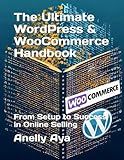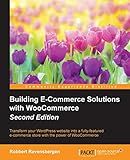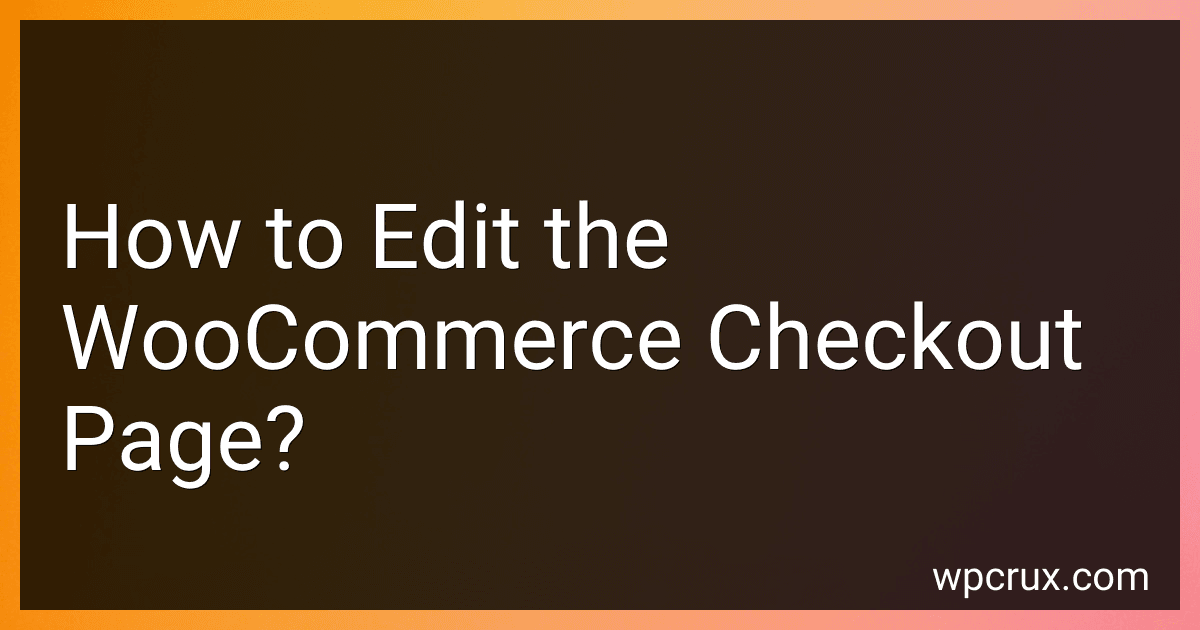Best WooCommerce Plugins to Buy in October 2025

The Ultimate WordPress & WooCommerce Handbook: From Setup to Success in Online Selling



WordPress WooCommerce: Tienda online con WooCommerce (Spanish Edition)



Building E-Commerce Solutions with WooCommerce - Second Edition



WordPress WooCommerce: Webshop met WooCommerce (Dutch Edition)



Formation Woocommerce: Créer et exploiter une boutique en ligne (French Edition)



Setting Up and Running an Online Store


To edit the WooCommerce checkout page, you can follow certain steps:
- Log in to your WordPress website dashboard.
- Navigate to "WooCommerce" in the left-hand menu and click on "Settings".
- In the "Settings" tab, click on the "Checkout" sub-tab.
- Here, you can make modifications to your checkout page by editing various fields and options.
- You can customize billing and shipping address fields, enable or disable guest checkout, and edit the order notes.
- Customize the layout and appearance by choosing a template from the "Checkout Pages" section. You can also add custom CSS if you want more advanced style modifications.
- Further down, you can manage payment gateways and configure the available payment methods for your customers.
- Save your changes by clicking on the "Save changes" button at the bottom of the page.
After making these changes, the WooCommerce checkout page will be updated according to your preferences. Remember to check the changes on the frontend to ensure everything looks and functions correctly.
Are there any limitations to editing the WooCommerce checkout page?
Yes, there are some limitations to editing the WooCommerce checkout page.
- Customizing the checkout page layout: WooCommerce provides some built-in customization options for the checkout page layout, but they are limited. To make extensive changes to the layout, it may require custom coding or using third-party plugins.
- Modifying checkout fields: Out of the box, WooCommerce allows you to show or hide certain fields on the checkout page, but it doesn't provide a simple interface to add or remove custom fields. To add or modify fields, you need to use custom code or third-party plugins.
- Changing the order of fields: By default, you can't easily change the order of fields on the checkout page. Again, custom code or plugins may be required to achieve this.
- Multistep checkout: WooCommerce doesn't offer a built-in option for creating a multistep checkout process. Customization is needed to implement a multistep checkout flow.
- Compatibility with themes and plugins: When customizing the checkout page, there can be compatibility issues with certain themes or plugins. It is important to test the changes thoroughly to ensure everything works properly.
Overall, while there are possibilities for customizing the WooCommerce checkout page, it may require advanced knowledge, coding skills, or third-party plugins to overcome these limitations and achieve the desired modifications.
What is the recommended approach for editing the WooCommerce checkout page?
The recommended approach for editing the WooCommerce checkout page is to use a child theme or a custom plugin. This allows you to make modifications to the checkout page without directly editing the core WooCommerce files.
Here are the steps you can follow to edit the WooCommerce checkout page:
- Create a child theme: If you don't already have a child theme, create one for your WordPress theme. This will ensure that your modifications remain intact even after theme updates.
- Locate the checkout page template: In your child theme, find the WooCommerce template file responsible for displaying the checkout page. The file can usually be found in the "woocommerce" folder within the theme.
- Copy the template file to your child theme: Once you've located the template file, copy it to the corresponding location within your child theme's folder structure. This will override the template file from the parent theme.
- Edit the template file: Open the copied template file in a text editor and make the desired changes to the layout, fields, or any other element of the checkout page. Modify the HTML, CSS, or PHP code as needed.
- Test and refine: Save the changes and test the checkout page on your website. Make any further refinements or adjustments as required.
- Use custom CSS or functions: If you only need to make minor changes, such as adjusting the styling or adding small modifications, you can use custom CSS or functions within your child theme's files. This avoids modifying the template file directly.
Remember to backup your website and theme files before making any modifications, and be cautious while editing code to avoid causing any unintended issues.
How can I change the default country on the WooCommerce checkout page?
To change the default country on the WooCommerce checkout page, you can follow these steps:
- Log in to your WordPress admin area.
- Go to the WooCommerce settings by clicking on "WooCommerce" in the left-hand menu.
- Click on the "General" tab.
- Scroll down to the "Default customer location" section.
- In the "Default country" dropdown, select the country you want to set as the default.
- Click on the "Save changes" button at the bottom of the page to save your settings.
Now, when a customer visits the checkout page, the selected country will be set as the default.
How can I add a coupon field to the WooCommerce checkout page?
To add a coupon field to the WooCommerce checkout page, you can follow the steps below:
- Login to your WordPress admin dashboard.
- Navigate to "Appearance" -> "Theme Editor" on the left-hand side menu.
- In the Theme Editor, locate the "functions.php" file on the right-hand side.
- Add the following code at the end of the "functions.php" file:
// Display coupon field on WooCommerce checkout page add_action( 'woocommerce_before_checkout_form', 'add_coupon_field_checkout' ); function add_coupon_field_checkout() { echo ' ' . __('Have a coupon?', 'woocommerce') . ' ' . __('Apply Coupon', 'woocommerce') . ' '; }
// Apply coupon on WooCommerce checkout submission add_action( 'woocommerce_checkout_process', 'apply_coupon_on_checkout' ); function apply_coupon_on_checkout() { if ( isset( $_POST['apply_coupon'] ) && ! empty( $_POST['coupon_code'] ) ) { $coupon_code = sanitize_text_field( $_POST['coupon_code'] ); WC()->cart->apply_coupon( $coupon_code ); } }
- Click on the "Update File" button to save the changes.
After following these steps, you should see a coupon field on the WooCommerce checkout page where customers can enter their coupon codes and apply them.
Can I enable order tracking functionality on the WooCommerce checkout page?
Yes, you can enable order tracking functionality on the WooCommerce checkout page. To do this, you can follow these steps:
- Install and activate a WooCommerce order tracking plugin. There are several available options in the WordPress plugin repository, such as "Order Tracking for WooCommerce" or "WooCommerce Shipment Tracking".
- After activation, go to the plugin settings or options page.
- Configure the settings according to your requirements. You may need to enter the tracking carrier names, tracking URLs, and customize the display options.
- Save the settings and the order tracking functionality will now be enabled on the WooCommerce checkout page.
- You can also customize the appearance and position of the tracking form by editing the checkout template file in your theme. The specific file to edit is usually checkout/form-tracking.php.
- Finally, test the functionality by placing a test order and accessing the order tracking feature on the checkout page.
Note: The steps may vary depending on the specific plugin and theme you are using. Always refer to the documentation provided by the plugin developer for detailed instructions.
Can I change the order of billing and shipping fields on the WooCommerce checkout page?
Yes, you can change the order of billing and shipping fields on the WooCommerce checkout page by modifying the template file or using a custom plugin. Here are two methods you can use to accomplish this:
- Modifying Template File: Copy the file woocommerce/templates/checkout/form-checkout.php to your theme folder. Open the copied file in a code editor. Locate the section where the billing and shipping fields are defined. Rearrange the order of the fields as desired, by moving the corresponding code blocks. Save the changes and refresh the checkout page to see the updated order.
- Using a Custom Plugin: Install and activate a custom functions plugin, such as Code Snippets or Custom Functions. Go to the plugin's settings page, usually located under "Appearance" or "Plugins" in the WordPress admin menu. Add a new snippet and enter the following code:
function change_checkout_fields_order( $fields ) { $fields['billing']['billing_first_name']['priority'] = 10; // Set priority as needed $fields['billing']['billing_last_name']['priority'] = 20; // Rearrange other billing fields if required
$fields\['shipping'\]\['shipping\_first\_name'\]\['priority'\] = 30;
$fields\['shipping'\]\['shipping\_last\_name'\]\['priority'\] = 40;
// Rearrange other shipping fields if required
return $fields;
} add_filter( 'woocommerce_checkout_fields', 'change_checkout_fields_order', 9999 );
- Modify the priority values for each field according to the desired order (lower numbers appear first).
- Save or activate the snippet, and then refresh the checkout page to see the changes.
Remember to backup your files or use a child theme/plugin to avoid losing any modifications during WooCommerce updates.
How can I add terms and conditions checkbox on the WooCommerce checkout page?
To add a terms and conditions checkbox on the WooCommerce checkout page, you can follow these steps:
- First, go to your WordPress dashboard and navigate to "Appearance" > "Theme Editor".
- In the theme editor, locate and open the "functions.php" file for editing.
- Inside the "functions.php" file, add the following code snippet:
// Add terms and conditions checkbox to checkout page function add_terms_and_conditions_checkbox() { $args = array( 'type' => 'checkbox', 'label' => 'I have read and agree to the terms and conditions', 'class' => array('form-row-terms'), 'required' => true, );
woocommerce\_form\_field( 'terms\_conditions', $args, WC()->checkout->get\_value( 'terms\_conditions' ) );
}
add_action( 'woocommerce_checkout_after_terms_and_conditions', 'add_terms_and_conditions_checkbox' );
- Save the changes in the "functions.php" file.
- Go to the WooCommerce > Settings page in your WordPress dashboard.
- Click on the "Advanced" tab and scroll to the "Checkout" section.
- Enable the "Enable Terms and Conditions" option.
- Configure the "Terms and Conditions" settings as per your requirements.
- Save the changes.
Now, you should see a terms and conditions checkbox displayed on the checkout page of your WooCommerce website. The customer will be required to check the box before they can proceed with the purchase.
Can I remove unnecessary fields from the WooCommerce checkout page?
Yes, you can remove unnecessary fields from the WooCommerce checkout page by using custom code or plugins.
If you are comfortable with coding, you can use filters and hooks provided by WooCommerce to remove or modify the checkout fields. WooCommerce uses a filter called woocommerce_checkout_fields to define the checkout fields. You can override this filter in your theme's functions.php file or in a custom plugin. Here is an example of how to remove the billing phone field:
function remove_billing_phone_field($fields) { unset($fields['billing']['billing_phone']); return $fields; } add_filter('woocommerce_checkout_fields', 'remove_billing_phone_field');
You can modify the code above to remove other fields by replacing 'billing_phone' with the field key you want to remove.
Alternatively, you can use plugins such as "Checkout Field Editor for WooCommerce" or "WooCommerce Customizer" which provide a user interface to manage the checkout fields and easily customize their display.
Remember to test any changes thoroughly to ensure they do not impact the functionality of your checkout process.
Can I enable address autocomplete on the WooCommerce checkout page?
Yes, you can enable address autocomplete on the WooCommerce checkout page by using a plugin or by manually adding code to your theme files. Here are two methods to achieve this:
- Using a Plugin: Install and activate the "Address Autocomplete for WooCommerce" plugin from the WordPress plugin repository. Once activated, go to WooCommerce -> Settings -> Address Autocomplete to configure the plugin settings. Enable the "Address Autocomplete" option, and select the required Google Maps API. Save the settings, and the address autocomplete feature should now work on the checkout page.
- Manually adding code: Open your theme's functions.php file or create a child theme if you haven't already. Add the following code to the functions.php file: // Enqueue Google Places API and Autocomplete script function woocommerce_address_autocomplete_script() { wp_enqueue_script('google-maps-api', 'https://maps.googleapis.com/maps/api/js?key=YOUR_API_KEY&libraries=places', array(), null, true); wp_enqueue_script('address-autocomplete', get_stylesheet_directory_uri() . '/js/address-autocomplete.js', array('jquery'), null, true); } add_action('wp_enqueue_scripts', 'woocommerce_address_autocomplete_script'); // Add custom checkout fields for address autocomplete function woocommerce_address_autocomplete_fields($fields) { $fields['billing']['billing_address_1']['autocomplete'] = 'address-line1'; $fields['billing']['billing_address_2']['autocomplete'] = 'address-line2'; $fields['billing']['billing_city']['autocomplete'] = 'address-level2'; $fields['billing']['billing_state']['autocomplete'] = 'address-level1'; $fields['billing']['billing_postcode']['autocomplete'] = 'postal-code'; return $fields; } add_filter('woocommerce_checkout_fields', 'woocommerce_address_autocomplete_fields'); Replace 'YOUR_API_KEY' in the first line of the code with your own Google Maps API key. Create a new folder called "js" in your theme directory if it doesn't exist, and create a new file called "address-autocomplete.js" inside the js folder. In the "address-autocomplete.js" file, add the following code: jQuery(document).ready(function($) { // Set up address autocomplete for billing address fields var billingAddress1 = new google.maps.places.Autocomplete(document.getElementById('billing_address_1')); var billingAddress2 = new google.maps.places.Autocomplete(document.getElementById('billing_address_2')); var billingCity = new google.maps.places.Autocomplete(document.getElementById('billing_city')); var billingState = new google.maps.places.Autocomplete(document.getElementById('billing_state')); var billingPostcode = new google.maps.places.Autocomplete(document.getElementById('billing_postcode')); }); Save the changes, and now the address autocomplete should be enabled on your WooCommerce checkout page.
Note: Ensure that you have obtained a valid Google Maps API key and replaced 'YOUR_API_KEY' with the actual key in the code.
